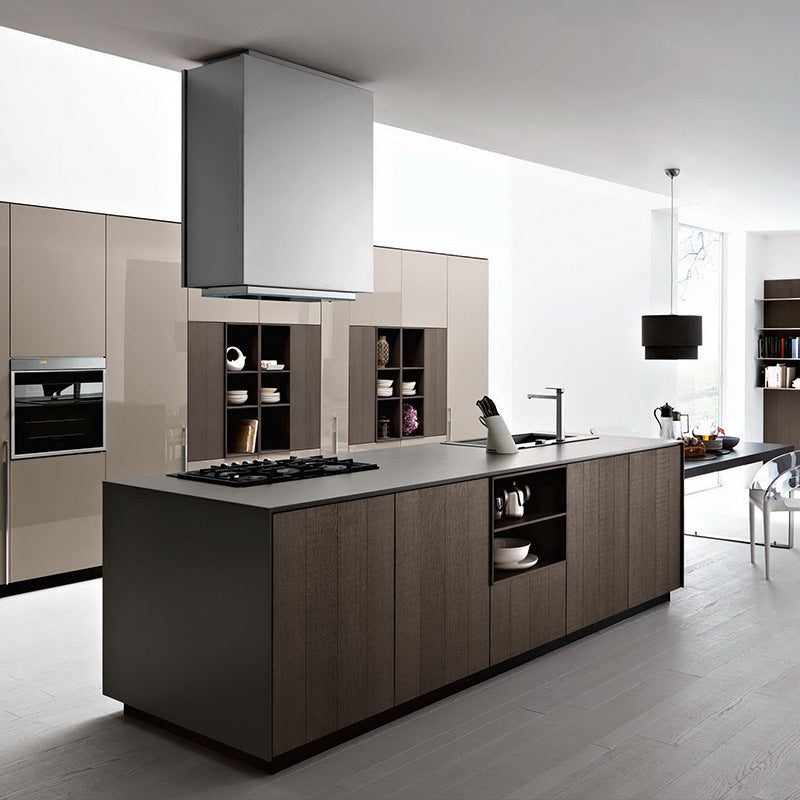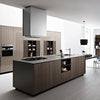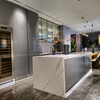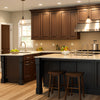Maximizing Functionality and Aesthetics: The Ideal Space Between a Kitchen Island and Table

Introduction
The heart of any home often resides in its kitchen – a space that is not just for cooking, but for socializing, dining, and creating memories. As the centerpiece of many homes, the layout of the kitchen becomes a crucial aspect of home design, influencing not only the aesthetic appeal of the space but also its functionality and efficiency. A well-thought-out kitchen layout can enhance the flow of activities, improve interaction among family members, and even increase the property's value.
Among the various elements of kitchen design, one of the most significant considerations is the spatial arrangement, particularly the distance between a kitchen island and a table. This aspect might seem trivial at first glance, but it holds immense importance in ensuring a harmonious balance between ease of movement, usability, and the overall feel of the kitchen space.
Determining the optimal space between a kitchen island and a table is more than just a matter of measurement. It involves a careful consideration of the kitchen's size, the homeowner's lifestyle, and the functional demands placed on these areas. Whether it's accommodating busy breakfasts on weekdays, hosting dinner parties, or providing ample room for meal preparation, the space between these two key components can significantly impact the kitchen's effectiveness and ambiance.
In this article, we delve into the intricacies of kitchen design, focusing on the critical question: How much space should there be between a kitchen island and a table? We will explore guidelines, design considerations, and expert tips to help you create not just a kitchen, but a dynamic living space tailored to your needs and preferences.

Understanding Kitchen Dynamics
The Spectrum of Kitchen Layouts
The design of a kitchen is often dictated by its layout. Common layouts include the U-shape, L-shape, galley, and open plan, each presenting unique challenges and opportunities for space management. For instance, a U-shaped kitchen offers ample counter space but might limit the placement of a table. In contrast, an open plan allows more flexibility but requires careful consideration to maintain a cohesive look.
Space Management in Different Layouts
Each layout demands a different approach to space management. In a galley kitchen, the focus is on maximizing efficiency in a narrow space, while in an L-shaped kitchen, the challenge lies in balancing the corner dynamics. The open plan layout offers more freedom but needs a harmonious integration of different functional areas without overcrowding.
The Evolving Role of the Kitchen Island
Once considered a luxury, the kitchen island has become a staple in modern homes. It serves multiple purposes: as a prep station, a dining area, an informal gathering spot, or even as additional storage. The island's versatility makes it a focal point in kitchen design, influencing how other elements, like the kitchen table, are positioned.
The Kitchen Table in Contemporary Design
The kitchen table, traditionally the heart of the home for meals and family gatherings, has evolved in its role. In modern homes, it often doubles as a workspace or a place for kids to do homework. The placement of the table relative to the kitchen island must accommodate these diverse functions while ensuring a seamless flow of movement.
Integrating Islands and Tables in Varied Layouts
In integrating both a kitchen island and a table, the key is to understand their roles and the interactions they facilitate. For example, in an open-plan kitchen, the island might act as a divider between the cooking area and the living space, while the table serves as the main dining area. In smaller layouts, the island and table may need to perform dual functions, making their placement even more critical.
The Impact of Layout on Space Between Island and Table
The chosen layout directly influences the amount of space needed between an island and a table. An L-shaped kitchen may offer more flexibility for spacing than a galley kitchen. Understanding the dynamics of each layout helps in making informed decisions about spacing, ensuring that both elements coexist harmoniously without compromising on functionality.
In the following sections, we will delve deeper into the specific guidelines and considerations for determining the ideal space between a kitchen island and a table, ensuring your kitchen is not only aesthetically pleasing but also perfectly suited to your lifestyle and needs.

The Importance of Space Planning
Space as the Backbone of Kitchen Functionality
The layout of a kitchen dictates its functionality, and at the core of this layout is effective space planning. The arrangement of different components, especially the distance between a kitchen island and a table, significantly affects how individuals move and interact within the space. Adequate space allows for smooth traffic flow, easy access to cabinets and appliances, and comfortable movement during cooking and dining activities.
Movement and Workflow Efficiency
In kitchen design, the concept of the "work triangle" – the area between the stove, sink, and refrigerator – is critical. The placement of the island and table in relation to this triangle can either enhance or hinder kitchen workflow. Proper spacing ensures that these areas are accessible without obstruction, maintaining an efficient workflow for cooking and other kitchen tasks.
The Perils of Overcrowding
Overcrowding in a kitchen can lead to a cramped and uncomfortable environment. When the space between an island and a table is too narrow, it restricts movement, makes it difficult to use kitchen appliances effectively, and can even pose safety hazards, especially in high-traffic situations. This congestion can also make the kitchen feel smaller and less welcoming.
The Drawbacks of Underutilization
Conversely, too much space between the island and table can make the kitchen feel disjointed and inefficient. It can lead to unnecessary steps while cooking or cleaning, making everyday tasks more time-consuming. Additionally, excessive space can diminish the sense of coziness and intimacy that many desire in their kitchen, especially in homes where the kitchen is a central gathering spot.
Balancing Space for Multi-Functionality
Modern kitchens often serve multiple purposes – from cooking and dining to socializing and working. Effective space planning ensures that these functions can coexist without interference. This balance is crucial in homes with open-plan kitchens, where the kitchen space blends into living or dining areas.
The Role of Space in Aesthetic Appeal
Beyond functionality, the spacing between kitchen elements also influences the aesthetic appeal of the space. Properly spaced furniture and fixtures can create a sense of harmony and flow, contributing to the overall visual appeal of the kitchen. It can highlight design features, like a statement island or a unique dining table, making them stand out as focal points.
In the next section, we will explore specific guidelines and factors that influence the ideal spacing between a kitchen island and a table, taking into account both practical and aesthetic considerations to achieve a kitchen that is not only beautiful but also highly functional.

Recommended Spacing Guidelines
General Spacing Guidelines
The National Kitchen and Bath Association (NKBA) suggests a general guideline for the distance between a kitchen island and a table or other countertops. Ideally, this should be between 36 to 48 inches (approximately 91 to 122 cm). This range allows for comfortable movement and accessibility while maintaining an efficient workflow in the kitchen.
Factors Influencing Space Requirements
Size of the Kitchen:
- In larger kitchens, there's more flexibility to increase the distance beyond the minimum recommended spacing, allowing for a more open feel.
- Smaller kitchens might require sticking closer to the minimum recommended distance to conserve space without sacrificing functionality.
Dimensions of the Island and Table:
- Larger islands or tables may require additional space to avoid a cramped feel.
- For smaller or narrower islands and tables, the lower end of the spacing guideline might be more appropriate.
Number of Users:
- Kitchens frequently used by multiple people simultaneously need more space to accommodate everyone comfortably.
- For less frequently used or single-person kitchens, the spacing can be on the lower end.
Usage Patterns:
- Kitchens used for extensive cooking and meal preparation might benefit from more space for ease of movement.
- If the kitchen's primary function is more social or for light cooking, slightly less space might be sufficient.
Storage and Appliances:
- Consideration should be given to the opening of appliance doors and access to storage. Adequate space should be allowed for these elements to function without obstruction.
Seating Arrangements:
- If the island or table includes seating, additional space might be required to comfortably pull out chairs or stools and allow for seating without blocking pathways.
Customizing to Individual Needs
While these guidelines provide a starting point, the ideal spacing can vary based on individual needs and preferences. It’s essential to consider the specific use-cases and lifestyle of the household. For instance, a family with young children might prioritize safety and ease of movement, while avid entertainers might prefer more space for guests to congregate.
Simulation and Mock-ups
Before finalizing the layout, it can be beneficial to simulate or create a mock-up of the space. This can involve using temporary markers or placeholders to represent the island and table, allowing for a practical assessment of the space and movement flow. Such a trial can help in making adjustments before any permanent installations are made.
In the next section, we will delve into design considerations for different kitchen sizes, providing tailored advice for maximizing both aesthetics and functionality in small, medium, and large kitchens.

Design Considerations for Different Kitchen Sizes
Small Kitchens
Space Maximization:
- Utilize slim and compact furniture to save space.
- Consider a smaller island or a movable island that can be tucked away when not in use.
Strategic Layout:
- Opt for an L-shaped layout to maximize corner space.
- Use vertical space for storage to keep the floor area clear.
Multi-functional Furniture:
- Choose tables with built-in storage or that can be folded or extended as needed.
- Implement seating that can be stored under the table or island.
Case Study:
- A small urban apartment where a foldable table is attached to the wall opposite a narrow island, allowing for dining space when needed and additional movement area when retracted.
Medium Kitchens
Flexible Design:
- Implement a moderate-sized island with space for seating and storage.
- Ensure enough room for appliance doors and cabinet drawers to open fully.
Balanced Layout:
- Opt for a classic U-shaped or L-shaped layout with an appropriately sized table to maintain workflow efficiency.
Zoning:
- Create distinct zones for cooking, dining, and storage without overcrowding any section.
Case Study:
- A suburban family kitchen with an L-shaped counter and a central island, where the table is placed near the kitchen but not directly adjacent, providing a clear path and separate dining area.
Large Kitchens
Spacious Layout:
- Allow for more generous spacing between the island and table.
- Consider larger or more elaborate islands with ample seating.
Multiple Work Zones:
- Create multiple work zones or stations for different tasks, enhancing functionality for frequent use or entertaining.
Design Harmony:
- Ensure the scale of the island and table matches the kitchen's size to maintain aesthetic balance.
- Consider an oversized or statement table as a focal point.
Case Study:
- A luxury home with an open-plan kitchen featuring a large central island for preparation and casual dining, and a separate, more formal dining area positioned with greater spacing for an open and airy feel.
Adapting to Architectural Features
In each kitchen size, the architectural features like windows, doors, and existing structural elements play a significant role in determining the layout. The design should adapt to these features, ensuring that the island and table complement rather than disrupt the existing space.
Integrating Style and Function
Regardless of the kitchen size, the aim should be to balance style with functionality. This involves choosing materials, finishes, and furniture that align with the overall home aesthetic while serving their practical purpose efficiently.
In the following sections, we will further explore how to balance aesthetics with functionality in kitchen design, and discuss common mistakes to avoid in kitchen layout planning.

VII. Common Mistakes to Avoid in Kitchen Design
Overlooking the Importance of Workflow
- Mistake: Ignoring the work triangle (the space between the sink, refrigerator, and stove), leading to an inefficient workflow.
- Rectification: Ensure that the island and table placement do not obstruct the work triangle. Maintain clear paths to each point, optimizing workflow efficiency.
Neglecting Adequate Circulation Space
- Mistake: Underestimating the amount of space needed for comfortable movement, resulting in cramped and inaccessible areas.
- Rectification: Adhere to recommended spacing guidelines, allowing for at least 36 to 48 inches between the island and table or other countertops. Adjust based on kitchen size and usage.
Inappropriate Scale of Furniture and Fixtures
- Mistake: Choosing oversized islands or tables for a small kitchen, or vice versa, disrupting the scale and balance of the space.
- Rectification: Select furniture proportionate to the kitchen’s size. In smaller kitchens, consider compact or multifunctional pieces.
Misjudging Storage Needs
- Mistake: Insufficient storage leading to cluttered countertops and inefficient use of space.
- Rectification: Plan for ample and innovative storage solutions. Utilize vertical space and consider built-in storage in islands and tables.
Underestimating Lighting Requirements
- Mistake: Poor lighting that affects both the functionality and ambiance of the kitchen.
- Rectification: Implement a combination of task, ambient, and accent lighting. Ensure work areas like islands and tables are well-lit.
Disregarding Ergonomics
- Mistake: Furniture and countertops at uncomfortable heights, causing strain during use.
- Rectification: Opt for ergonomically designed furniture and adjust countertop heights to suit the primary users.
Overlooking the Balance Between Aesthetics and Function
- Mistake: Focusing too much on the kitchen's look at the expense of practicality, or vice versa.
- Rectification: Strike a balance between style and functionality. Choose materials and designs that are both beautiful and practical.
Failing to Plan for Future Needs
- Mistake: Designing a kitchen that suits current needs but doesn’t account for future changes in lifestyle or family size.
- Rectification: Design with adaptability in mind. Consider elements that can be easily altered or upgraded.
Ignoring Personal Style and Comfort
- Mistake: Following trends or styles that don’t resonate with personal preferences, leading to a kitchen that feels impersonal or uncomfortable.
- Rectification: Incorporate personal style and comfort into the design. The kitchen should reflect the tastes and needs of those who use it most.
By avoiding these common pitfalls, you can ensure that your kitchen is not only aesthetically pleasing but also a functional and enjoyable space. In the next section, we will explore expert opinions and tips for homeowners planning a kitchen renovation or design.

VII. Common Mistakes to Avoid in Kitchen Design
Overlooking the Importance of Workflow
Mistake: Placing the kitchen island in a way that obstructs the flow between the sink, refrigerator, and stove, creating an inefficient work triangle. Rectification: Position the island to complement the work triangle. Ensure there's enough space for easy movement between these key areas without any obstruction.
Neglecting Adequate Circulation Space
Mistake: Underestimating the necessary space for comfortable movement, leading to cramped and difficult-to-navigate areas in the kitchen. Rectification: Follow the recommended spacing guidelines, ensuring a distance of at least 36 to 48 inches between the island and table or other countertops. This should be adjusted according to the specific size and usage patterns of the kitchen.
Disproportionate Sizing of Furniture
Mistake: Choosing an island or table that's too large for a small kitchen, overwhelming the space and disrupting the balance. Rectification: Select furniture that's proportionate to the size of the kitchen. In smaller spaces, consider compact, multifunctional, or customizable pieces that can adapt to the available area.
Insufficient Storage Planning
Mistake: Failing to provide enough storage, leading to cluttered countertops and a disorganized kitchen space. Rectification: Plan for adequate storage solutions, such as integrated cabinets in the island, overhead shelving, or multi-use furniture with built-in storage features.
Inadequate Lighting
Mistake: Poor or insufficient lighting, especially in critical areas like the island and table, affecting functionality and ambiance. Rectification: Enhance the kitchen lighting by incorporating layered lighting solutions, including task lighting from clean LED profiles over workspaces and ambient lighting for general illumination.
Ignoring Ergonomic Considerations
Mistake: Having countertops or seating at uncomfortable heights, causing inconvenience and strain during use. Rectification: Customize countertop heights and select adjustable or ergonomically designed seating to cater to the comfort and needs of all users.
Mistake: Focusing too much on the kitchen’s aesthetic appeal, resulting in a lack of practical functionality. Rectification: Balance the design choices by considering practical aspects such as ease of cleaning, durability of materials, and the efficiency of the layout alongside aesthetic preferences.
Not Planning for Future Changes
Mistake: Designing a kitchen that suits current needs but does not account for potential changes in family size or lifestyle.
Rectification: Implement adaptable and flexible design elements that can easily be modified or upgraded to suit future needs, ensuring the kitchen remains functional over time.
Over-reliance on Trends
Mistake: Choosing design elements solely based on current trends, which may not align with personal preferences or the long-term usability of the space.
Rectification: Integrate personal tastes and practical needs into the kitchen design, ensuring the space remains timeless and enjoyable for years to come.
By being aware of and addressing these common design mistakes, homeowners can create a kitchen that is not only visually appealing but also highly functional and suited to their lifestyle.

VIII. Expert Opinions and Tips
For those embarking on the journey of kitchen renovation or design, insights from interior designers and architects can be immensely valuable. Their experience in tackling various design challenges offers a treasure trove of knowledge. Here are some distinct expert opinions and practical advice, diverging from the general tips previously discussed:
Embracing the Concept of Negative Space
- Expert Insight: Designers often highlight the importance of negative space – the open areas around elements like islands and tables.
- Practical Advice: Don’t feel compelled to fill every inch of your kitchen. Allowing for open space can make the kitchen feel larger and more inviting.
The Integration of Technology
- Expert Insight: Technological integration in the kitchen should be thoughtful and purposeful, according to tech-savvy architects.
- Practical Advice: Consider smart appliances that sync with your lifestyle, like a refrigerator that can help with grocery lists or an oven you can control with your smartphone.
The Illusion of Space with Color and Light
- Expert Insight: Designers often use color and lighting to create the illusion of more space.
- Practical Advice: Use lighter colors for cabinets and walls to make the kitchen appear larger. Strategically place mirrors to reflect light and enhance the sense of space.
The Trend of Eco-Friendly Design
- Expert Insight: There's a growing trend towards sustainable, eco-friendly kitchen designs.
- Practical Advice: Use materials like bamboo for flooring or recycled glass for countertops. Consider energy-efficient appliances to reduce your environmental footprint.
The Importance of Personal Zones
- Expert Insight: Personalized zones in the kitchen, dedicated to specific tasks or family members, are becoming popular.
- Practical Advice: Create a small coffee station, a baking area with all necessary tools, or a kid-friendly section at a lower height to encourage independence.
The Relevance of Texture
- Expert Insight: Texture plays a significant role in adding depth and interest to kitchen designs.
- Practical Advice: Mix and match materials like wood, metal, and stone. Consider textured backsplashes or patterned floor tiles to add character.
The Shift Towards Bold Statement Pieces
- Expert Insight: Making a statement with a bold piece of furniture or art is a trend designers love for adding personality to a kitchen.
- Practical Advice: Choose a vibrant color for your island or a unique piece of art. These can serve as conversation starters and focal points.
The Art of Layering in Design
- Expert Insight: Layering different design elements is a technique used to create a rich and dynamic kitchen environment.
- Practical Advice: Combine various lighting sources, mix materials and textures, and layer colors and patterns to create a visually engaging space.
The Value of Handcrafted Elements
- Expert Insight: Custom, handcrafted elements bring uniqueness and personal touch to the kitchen.
- Practical Advice: Invest in handcrafted tiles for your backsplash or custom-made cabinet handles. These details can make your kitchen truly one-of-a-kind.
These insights and tips go beyond the basics, offering fresh perspectives and innovative ideas for those looking to create a kitchen that is not only functional and beautiful but also reflects the latest trends and personal tastes in kitchen design.
Conclusion
In this comprehensive guide, we've navigated through the essentials of kitchen design, emphasizing the critical balance between functionality and aesthetics. Key points included the importance of space planning, especially the crucial distance between the kitchen island and table, design adaptations for varying kitchen sizes, the integration of both aesthetic appeal and practical utility, strategies to avoid common design pitfalls, and the incorporation of expert insights and tips. These elements collectively highlight the importance of a well-thought-out kitchen space that is not only efficient and comfortable but also a true reflection of personal style and needs.
As you embark on your journey of creating or remodeling your kitchen, remember to meld functionality with your unique design preferences. The kitchen, often the heart of a home, should not only cater to your practical needs but also resonate with your personal aesthetic, making it a space of comfort, efficiency, and joy.
FAQs
- What is the Ideal Space Between Kitchen Island and Table?
- Discover the recommended distance for optimal functionality and design in your kitchen. Learn how spacing affects movement, efficiency, and the overall aesthetics of your kitchen layout.
- How to Design a Kitchen for Different Sizes?
- Explore tailored design strategies for small, medium, and large kitchens. Find out how to maximize space, incorporate stylish elements, and maintain functionality regardless of your kitchen's size.
- What are Common Kitchen Design Mistakes to Avoid?
- Uncover frequent errors in kitchen planning and design, and learn practical solutions to avoid them. Improve your kitchen's functionality and style by understanding these common pitfalls.
- How to Balance Functionality and Aesthetics in Kitchen Design?
- Get expert tips on creating a harmonious kitchen space that combines practical utility with aesthetic appeal. Learn about material selection, furniture placement, and lighting considerations.
- What are the Latest Trends in Eco-Friendly Kitchen Design?
- Stay updated with sustainable and eco-friendly kitchen design trends. Learn about using materials like sintered stone, energy-efficient appliances, and other green design practices.




